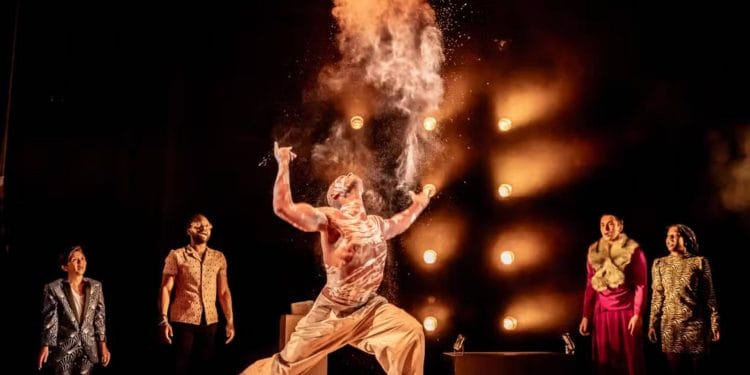 Mlima’s Tale, Lynn Nottage’s hypnotic poetic play about the slaughter of elephants and man’s relentless complicity in the ivory trade, mesmerises from beginning to end.
Mlima’s Tale, Lynn Nottage’s hypnotic poetic play about the slaughter of elephants and man’s relentless complicity in the ivory trade, mesmerises from beginning to end.
African elephants play an important role in the ecosystems of the savannah. According to the World Wildlife Fund, over the last 50 years the population of African savannah elephants has decreased by at least 60%, and may disappear by 2040 due to poaching for ivory and loss of habitat.
The play opens with Mlima recalling how his mother warned him because of his ‘mountain size’ and outstanding long symmetrical tusks (his 2 tusks alone have equal worth to ten), that he would always be a target for poachers.
Milma is now 48-year-old years old and is one of the last ‘big tuskers’ on the Kenyan savannah. He was once known as a warrior but now he is slowing down and he can never catch his breath as he is aware he is being hunted by men:
“They are watching me. Watching always. I hear them all around me. And I run, more than I walk.” Soon afterwards poachers kill Mlima. They brutalise his remains, and he becomes a spirit: “If you not give elephant proper burial he’ll haunt you forever.”
Mlima is just as imposing dead as alive. To make their guilt visible, the ghostly Mlima, then smears his torso and face with white paint, and as he follows the illicit trail that leads to the sale of his tusks from Africa to Vietnam, he marks all those who are involved. This smudging represents the transference of corruption, greed and vanity of man.
This is didactic theatre, in which Nottage suggests that that we may be all implicated in Milma’s Tale because within the international system of economic power we have created the demand for beautiful things, and that we as human’s rarely question it’s ethical origins as a buyer.
With haunting, dignified, graceful movements, Ira Mandela Siobhan gives an exquisite performance as Mlima. He captures each painful step of his tusk’s journey. From them being ripped from his body to being owned in a sculpture ‘made from his soul’. In one of the most moving scenes he is surrounded by voices of generations of murdered elephants.
The numerous figures that are involved in this nefarious daisy-chain sale, include corrupt law enforcement and customs officials, bribed sea captains and elite art buyers. All are capably portrayed by the supporting ensemble cast of four.
Under Miranda Cromwell’s fluid direction, there is a perfect symbiosis of stunning vocal harmonies composed by Femi Temowo, evocative sound design by Emma Laxton, and movement by Shelley Maxwell.

















